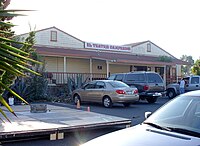Welcome to the Hispanic and Latino Americans portalHispanic and Latino Americans ( Spanish: Estadounidenses hispanos y latinos; Portuguese: Estadunidenses hispânicos e latinos) are Americans of Spanish and/or Latin American ancestry. These demographics include all Americans who identify as Hispanic or Latino regardless of ancestry. As of 2020, the Census Bureau estimated that there were almost 65.3 million Hispanics and Latinos living in the United States and its territories. "Origin" can be viewed as the ancestry, nationality group, lineage or country of birth of the person or the person's parents or ancestors before their arrival in the United States of America. People who identify as Hispanic or Latino may be of any race, because similar to what occurred during the colonization and post-independence of the United States, Latin American countries had their populations made up of descendants of white European colonizers (in this case Portuguese and Spaniards), Native peoples of the Americas, descendants of African slaves, post-independence immigrants coming from Europe, Middle East and East Asia, as well as descendants of multiracial unions between these different ethnic groups. As one of the only two specifically designated categories of ethnicity in the United States, Hispanics and Latinos form a pan-ethnicity incorporating a diversity of inter-related cultural and linguistic heritages, the use of the Spanish and Portuguese languages being the most important of all. Most Hispanic and Latino Americans are of Mexican, Puerto Rican, Cuban, Salvadoran, Dominican, Colombian, Guatemalan, Honduran, Ecuadorian, Peruvian, Venezuelan or Nicaraguan origin. The predominant origin of regional Hispanic and Latino populations varies widely in different locations across the country. In 2012, Hispanic Americans were the second fastest-growing ethnic group by percentage growth in the United States after Asian Americans. ( Full article...) Selected article Selected imageDid you know...
2013 Things you can do
Selected biography Luis Valdez was born in Delano, California to migrant farm worker parents. The second of ten children in his family, Valdez began to work in the fields at the age of six. Throughout his childhood, the family moved from harvest to harvest around the central valleys of California. Due to this peripatetic existence, he attended many different schools before the family finally settled in San Jose, California. (more...) SubcategoriesRelated PortalsAssociated WikiProjects
Hispanic and Latino American TopicsAfro-Latin American | Asian Hispanic and Latino Americans | Black Hispanic and Latino Americans | Californio | Chicano | Cuban American | Demographics of Hispanic and Latino Americans | Hispanic | Hispanic Americans in World War II | Hispanic and Latino Americans | Hispanic–Latino naming dispute | Hispanos | Latino | List of Hispanic and Latino Americans | MEChA | Mexican American | Puerto Rican people | Spanish language in the United States | Tejano | White Hispanic and Latino Americans Associated WikimediaThe following Wikimedia Foundation sister projects provide more on this subject:
Discover Wikipedia using
portals |






















